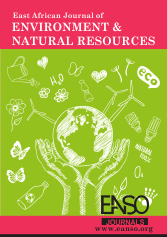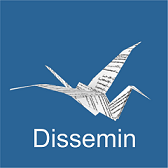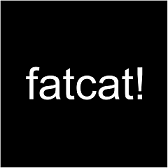Application of SWAT and WEAP Models for Sustainable Management of Water Resources in the Two Rivers Dam Catchment, Uasin Gishu County, Kenya
Abstract
Kaptagat Forest, the main source of the Ellegerini River, which feeds the Ellegerini Dam and Two Rivers Dam, is under threat of extinction due to human activity. The Two Rivers Dam catchment that has over the years been a source of water in Uasin Gishu County is slowly depleting and urgent measures are required to restore it. Activities including commercial logging, charcoal burning and firewood harvesting have exerted a lot of pressure on the catchment, posing a great threat to the livelihoods of the people of Eldoret town who depend on the reservoirs for water supply. The main objective of this study was to customise SWAT and WEAP models for the sustainable management of water resources in the Two Rivers Dam catchment. The specific objectives were to set up and apply the SWAT model to generate simulated river flows draining to the Two Rivers and Ellegerini Reservoirs as an input to the WEAP model to determine the impact of land use change on the hydrological function of the Two Rivers Dam catchment, to set up, calibrate and validate a WEAP model for the Two Rivers Dam catchment and to apply the WEAP model in analyses of various management and infrastructural development projects scenarios to enhance river flow and water storage in the Two Rivers and Ellegerini Reservoirs. The goodness of fit SWAT model statistical evaluation indices attained during the calibration period was R2 = 0.854, NSE = 0.822 and Bias = 0.392. Additionally, for the validation period, the R2 = 0.786, NSE = 0.815 and Bias = 0.381. The modelled results indicate that the land use change resulted in decreased baseflow and increased surface runoff hence the high fluctuations of water levels in the Two Rivers and Ellegerini reservoirs. The WEAP model results for actual and simulated water demand in the calibration period of 2019, the R2 = 0.88, while during the validation period in the year 2020, the R2 = 0.85. The results of the model simulation indicated that the management option that had the most impact on all the scenarios was the reduction of unaccounted-for water, while the one with the least impact was increased water use efficiency. It was concluded that the models were able to simulate the observed conditions reasonably well and can therefore be used to effectively manage water resources and assist the relevant stakeholders in decision-making. The study recommended that forested areas need to be properly conserved in order to restore the hydrological function of the catchment.
Downloads
References
Agarwal, S., Patil, J. P., Goyal, V. C., & Singh, A. (2019). Assessment of water supply–demand using water evaluation and planning (WEAP) model for Ur River watershed, Madhya Pradesh, India. Journal of The Institution of Engineers (India): Series A, 100(1), 21–32.
Amin, A., Iqbal, J., Asghar, A., & Ribbe, L. (2018). Analysis of current and future water demands in the Upper Indus Basin under IPCC climate and socio-economic scenarios using a hydro-economic WEAP model. Water, 10(5), 537.
Cao, W., Bowden, W. B., Davie, T., & Fenemor, A. (2006). Multi‐variable and multi‐site calibration and validation of SWAT in a large mountainous catchment with high spatial variability. Hydrological Processes: An International Journal, 20(5), 1057-1073.
Giordano, M., & Shah, T. (2014). From IWRM back to integrated water resources management. International Journal of Water Resources Development, 30(3), 364–376.
Hamlat, A., Errih, M., & Guidoum, A. (2013). Simulation of water resources management scenarios in western Algeria watersheds using the WEAP model. Arabian Journal of Geosciences, 6(7), 2225–2236.
Höllermann, B., Giertz, S., & Diekkrüger, B. (2010). Benin 2025 Balancing Future Water Availability and Demand Using the WEAP ‘ Water Evaluation and Planning ’ System. 3591–3613.https://doi.org/10.1007/s11269- 010- 9622-z
Kenya Forest Service. (2014). Kaptagat forest. Retrieved February 7, 2020, from http://www.kenyaforestservice.org/?option=com_content&view=article&id=700%3Akaptagat-forest&catid=185
Kimani, P. (2014). Hydrological modelling of the Sergoit Basin for the estimation of catchment yield: A comparative study of the “Lumped Conceptual MIKE 11 NAM” and the “Semi Distributed Physically Based SWAT” models. [Master’s thesis, Moi University]. http://ir.mu.ac.ke:8080/xmlui/handle/123456789/883
Krysanova, V., & Srinivasan, R. (2014). Assessment of climate and land use change impacts with SWAT. Regional Environmental Change, 15(3), 431– 434. https://doi.org/10.1007/s10113-014-0742-5
Li, X., Zhao, Y., Shi, C., Sha, J., Wang, Z. L., & Wang, Y. (2015). Application of Water Evaluation and Planning (WEAP) model for water resources management strategy estimation in coastal Binhai New Area, China. Ocean and Coastal Management, 106, 97–109. https://doi.org/10.1016/j.ocecoaman.2015.01.016
Loucks, D. P. (2005). Examples Decision Support Systems for River Basin Simulation. ECommons Cornell’s Digital Repository, 1– 5. https://ecommons.cornell.edu/handle/1813/2830
Maliehe, M., & Mulungu, D. M. M. (2017). Assessment of water availability for competing uses using SWAT and WEAP in South Phuthiatsana catchment, Lesotho. Physics and Chemistry of the Earth, 100(May 2012), 305–316. https://doi.org/10.1016/j.pce.2017.02.014
Marhaento, H., Booij, M. J., Rientjes, T. H. M., & Hoekstra, A. Y. (2017). Attribution of changes in the water balance of a tropical catchment to land use change using the SWAT model. Hydrological Processes, 31(11), 2029–2040. https://doi.org/10.1002/hyp.11167
Masakha, E. J. (2017). Seasonal and Longitudinal Variations of Water Quality in an Urban Stream : Case Study of Sosiani River Uasin Gishu County. 33
MIBP (2018). Water Supply Masterplan for Eldoret and Surrounding Satellite Towns. Mangat IB Patel Consulting Engineers.
N. Pai, & D. Saraswat. (2011). SWAT2009_LUC: A Tool to Activate the Land Use Change Module in SWAT 2009. Transactions of the ASABE, 54(5), 1649–1658. https://doi.org/10.13031/2013.39854
Ontumbi, G., Obando, J., & Ondieki, C. (2015). The Influence of Agricultural Activities on the Water Quality of the River Sosiani in Uasin Gishu County, Kenya. 2(1), 34–40.
Pokhrel, B. K. (2018). Impact of land use change on flow and sediment yields in the Khokana outlet of the Bagmati River, Kathmandu, Nepal. Hydrology, 5(2). https://doi.org/10.3390/hydrology5020022
Purkey, D. R., Joyce, B., Vicuna, S., Hanemann, M. W., Dale, L. L., Yates, D., & Dracup, J. A. (2008). Robust analysis of future climate change impacts on water for agriculture and other sectors: a case study in the Sacramento Valley. Climatic Change, 87(1), 109–122.
Shi, P., Hou, Y., Xie, Y., Chen, C., Chen, X., Li, Q., Qu, S., Fang, X., & Srinivasan, R. (2013). Application of a swat model for hydrological modeling in the Xixian watershed, China. Journal of Hydrologic Engineering, 18(11), 1522– 1529. https://doi.org/10.1061/(ASCE)HE.1943-5584.0000578
Sieber, J. (2006). WEAP water evaluation and planning system.
Sum, L. K. (2014). Modelling of water demand and supply of Chebara reservoir using WEAP model. [Master’s thesis, Moi University]. Retrieved from http://ir.mu.ac.ke:8080/xmlui/handle/123456789/1651
Tasdighi, A., Arabi, M., & Harmel, D. (2018). A probabilistic appraisal of rainfall-runoff modelling approaches within SWAT in mixed land use watersheds. Journal of Hydrology, 564, 476– 489. https://doi.org/10.1016/j.jhydrol.2018.07.035
Van Griensven, A., & Meixner, T. (2006). Methods to quantify and identify the sources of uncertainty for river basin water quality models. Water Science and Technology, 53(1), 51-59.
Copyright (c) 2023 Dennis Mailu Kiamba, Emmanuel Chessum Kipkorir, Job Rotich Kosgei, Simon Mburu Njoroge, Gilbert Nyageikaro Nyandwaro

This work is licensed under a Creative Commons Attribution 4.0 International License.




























